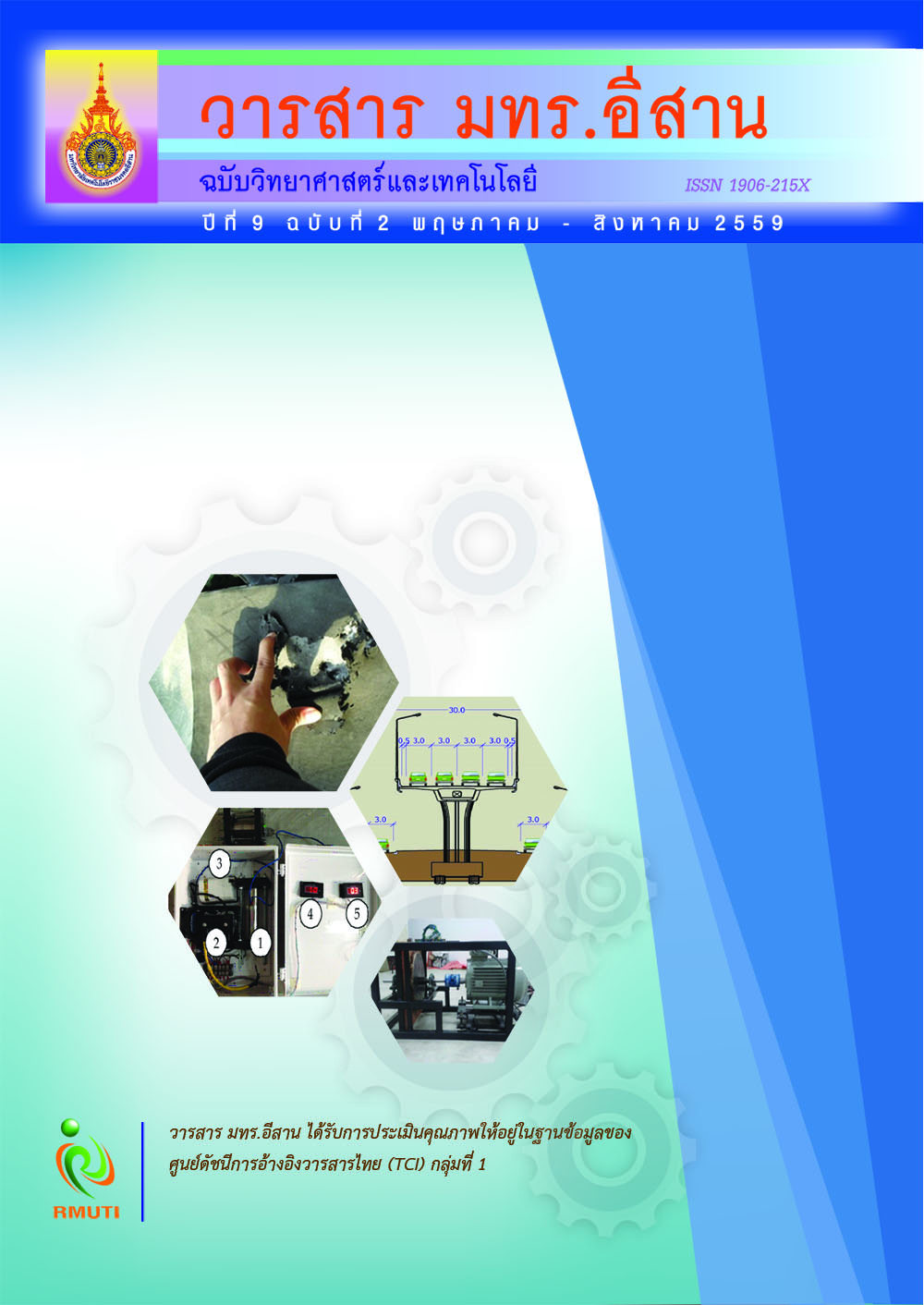การประยุกต์ใช้โอโซนเพื่อบำบัดนํ้าเหลือทิ้งจากกระบวนการผลิตก๊าซชีวภาพ The Application of Ozone for Wastewater Treatment from Biogas Process
Main Article Content
Abstract
บทคัดย่อ
บทความนี้เป็นการศึกษาผลของก๊าซโอโซนต่อการบำบัดนํ้าเหลือทิ้งจากกระบวนการผลิตก๊าซชีวภาพ
โดยก๊าซโอโซนได้มาจากการแตกตัวของโมเลกุลก๊าซในอากาศที่มีก๊าซออกซิเจนเป็นองค์ประกอบภายใต้
สนามไฟฟ้าความเครียดสูง ซึ่งในการทดลองทำการสร้างอิเล็กโทรดทรงกระบอกซ้อนแกนร่วมสำหรับ
ผลิตก๊าซโอนโซน จำนวน 2 แท่ง มีความยาว 7.5 cm (E1) และ 15 cm (E2) โดยทั้ง 2 แท่ง มีรัศมี
r1 = 1 cm และ r2 = 1.25 cm เท่ากัน ทำการทดลองเพื่อหาอัตราการเกิดก๊าซโอโซนและผลของ
ก๊าซโอโซนต่อการบำบัดนํ้าเหลือทิ้งจากกระบวนการผลิตก๊าซชีวภาพ โดยทำการวัดค่า VFA (Volatile
Fatty Acid), ALK (Alkalinity) COD (Chemical Oxygen Demand) ผลที่ได้คืออิเล็กโทรดที่มี
ความยาวมากกว่าให้อัตราการเกิดก๊าซโอโซนที่สูงกว่าและได้ผลของการบำบัดนํ้าเหลือทิ้งดีกว่าที่เวลาเท่ากัน
Abstract
This paper presents the result of ozone gases with the wastewater treatment from
biogas production. The ozone gases were produced by ionization reaction of oxygen
molecule in air under high stress electric field. Two co-axial cylindrical electrodes
were made. The length of the first electrode was 7.5 cm and the second electrode was
15 cm. The radius of the inner and outer electrodes were 1 cm and 1.25 cm. The ozone
production rate and the treatment performance were studied in term of VFA (Volatile
Fatty Acid), Alk (Alkalinity) and COD (Chemical Oxygen Demand). The result showed
that ozone gases production rate and performance of wastewater treatment were better
with the longer electrode under a given test period.
Article Details
References
Wasteaater. Department of Alternative Energy Development and Efficiency
Ministry of Energy
Chamnoi, B. (2009). Feasibility Study of Huachiew Chalermprakeit University Wastewater
Treatment System. HCU journal. Vol. 12. No. 24. pp. 53-71
Kittiyarangsit, K. (2011). Investment and Return Analysis of Biogas Power Plants. Master
of Degree in Environmental Engineering. Suranaree University of Technology
Khunteegul, O. and Petiraksakul, A. (2007). Optimization of Ink Wastewater Treatment
by Ozonation. KKU Engineering Journal. Vol. 34. Issue. 2. pp. 177-188
Nopharatana, A., Clarke, W., Pullammanappallil, P., Silvey, P. and Chynoweth, D.P. (1998).
Evaluation of Methanogenic Activities During Anaerobic Digestion of Municipal
Solid Waste. Bioresources Technology. Vol. 64. Issue. 3. pp.163-174
Petroleum Institute of Thailand. (1996). The ONLY and MOST Comprehensive Legal
Database for Petroleum and Petrochemical Industries. (In Thai)
Phonphunthin, T., Uttamaprakrom, W. and Reubroycharoen, P. (2014). A Study of Biogas
Production Potential from Industrial Wastewater. Energy Research Institute.
Vol. 11. No. 1. pp. 50-62
Sawangpol, K., Tia, W. and Chaiprasert, P. (2013). A Feasibility Study of Power Generation
using Biogas from Cellulosic Materials. KMUTT Research and Development
Journal. Vol. 36. No. 4. pp. 477-492
Sombatsompop, K. (2008). Wastewater Treatment by Sequencing Batch Reactor System.
Journal of KMUTNB. Vol. 18. No. 3. pp. 96-103
Sugai, T. and Minamitani, Y. (2013). Influence of Rise Rate of Applied Voltage for Water
Treatment by Pulsed Streamer Discharge in Air-Sprayed Droplets. IEEE
Transaction on Plasma Science. Vol. 41. Issue. 8. pp. 2327-2334
Tonkaya, N. and Wongwattanasatien, T. (2011). Design and Testing of Fertilizer Pelletizing
Machine using Biogas Dual Fuelled with Diesel Fuel.


